Are you noticing small, buzzing invaders taking over your living space? Identifying and eliminating these pests can be challenging, but flyermedia.net provides the solutions you need to reclaim your home. From understanding their behavior to implementing effective control strategies, we’ll help you create a pest-free environment with integrated pest management that works.
1. Identifying Common Types of Small Flying Bugs in Your House
Before you launch a full-scale pest control operation, knowing your enemy is crucial. Many flying insects might want to call your home their own, but a few common culprits are often mistaken for one another. Let’s break down the characteristics of gnats, fruit flies, drain flies, and clothes moths to help you accurately identify the pests in your home.
1.1. Gnats
What do gnats look like?
Gnats typically appear black and slender with long legs and antennae. Measuring no more than 3.3mm, they are small but noticeable when they gather in swarms.
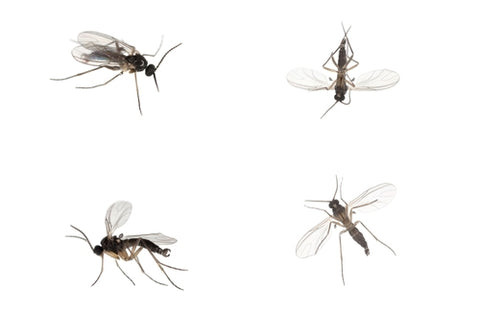 Gnats
Gnats
How do gnats get into your house?
Gnats are adept at finding entry points, squeezing through cracks in walls, foundations, and even the smallest gaps around doors and windows.
Where do gnats live in your home?
Damp, dark environments with decomposing matter are ideal for gnats. Look for them in trash cans, near sinks, drains, toilets, and around rotting fruit.
When are gnats most active?
Gnats prefer dusk and dawn and thrive in wet seasons like spring and winter.
Other characteristics of gnats:
Some gnats, such as fungus gnats, are known to bite and potentially transmit infectious diseases.
1.2. Fruit Flies
What do fruit flies look like?
Fruit flies, closely related to gnats, range from tan to black and have an oval shape, measuring about 3-4mm long. Many, though not all, have distinctive red eyes.
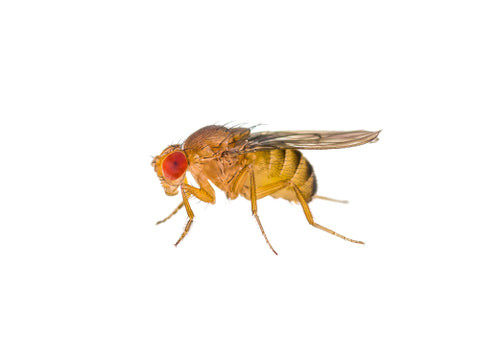 Fruit flies
Fruit flies
How do fruit flies get into your home?
Fruit flies are often brought into homes on fruits and vegetables.
Where do fruit flies live in your home?
As their name suggests, fruit flies are commonly found around overripe or rotting fruit, feasting on the yeasts and sugars produced. They also lay eggs on fruit skins and are attracted to drains clogged with food and spilled alcohol.
When are fruit flies most active?
Fruit flies are most active on warm, sunny days and are prevalent during late summer and fall.
Other characteristics of fruit flies:
Fruit flies are attracted to a variety of fruits, vegetables, and fungi, including apples, bananas, melons, potatoes, onions, and mushrooms.
1.3. Drain Flies
What do drain flies look like?
Drain flies, also known as sewage flies, filter flies, or moth flies, are light gray or tan and range from 1.5mm to 5mm in length. They have long antennae and bodies covered in small hairs, making them easy to mistake for moths.
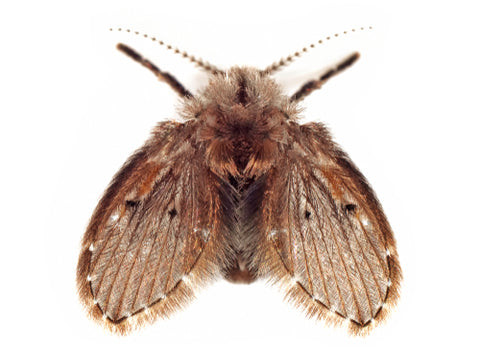 Drain flies
Drain flies
How do drain flies get into your home?
Drain flies find their way into homes by detecting drains rich in organic material. They enter through windows, doors, or tiny holes, rather than through the drains themselves.
Where do drain flies live in your home?
Unsurprisingly, drain flies thrive in drains, especially garbage disposals. They lay eggs in the gunk lining clogged pipes and feed on sewage or decomposing organic matter.
When are drain flies most active?
Drain flies are most active at night and during the summer, though they can survive in warm homes during winter.
Other characteristics of drain flies:
Drain flies are not strong fliers, often hopping or walking short distances. Spotting them in flight usually indicates they are near their breeding ground.
1.4. Clothes Moths
What do clothes moths look like?
There are two primary types of clothes-eating moths: casemaking clothes moths and webbing clothes moths. Casemaking moths create a silken case during their larval stage, while webbing moths leave webbing where they feed.
Adult casemaking moths are gray-brown with dark spots, while webbing moths are golden-yellow with a slight sheen. Both are approximately 15mm long.
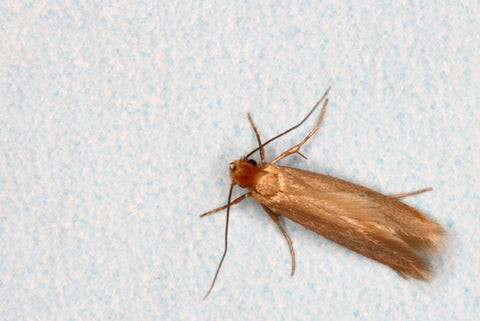 Webbing moth
Webbing moth
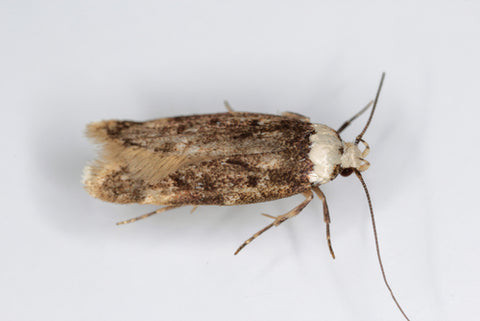 Casemaking clothes moths
Casemaking clothes moths
How do clothes moths get into your home?
Clothes moths often enter homes via items from thrift stores, secondhand shops, consignment stores, or garage sales, hiding under shirt collars, cuffed sleeves, seams, and buttons.
Where do clothes moths live in your home?
Clothes moths are typically found in dark closets but also infest carpets, upholstery, tapestries, stuffed animals, taxidermied animals, and craft materials like yarn.
When are clothes moths most active?
Clothes moths are most active at night, thriving outdoors in the springtime but living year-round in warm homes.
Other characteristics of clothes moths:
Clothes moth larvae, not the adults, cause damage by feeding on animal fibers such as cashmere, feathers, fur, felt, leather, silk, and wool.
2. How Can You Get Rid of Flying Bugs?
2.1. Target Hotspots for Some Immediate Relief
When dealing with a sudden influx of flying insects, immediate action is often the first priority. Targeting hotspots provides quick relief, especially when time is limited.
One effective approach is using insecticidal sprays designed to kill flying pests on contact. These sprays can be applied in areas where bugs congregate, such as near windows, doors, and light fixtures. According to the Environmental Protection Agency (EPA), when using pesticides, always follow label instructions carefully to ensure safe and effective use.
Another option is setting up traps specifically designed for flying insects. These traps use bait or light to attract bugs and prevent them from escaping. They are particularly useful in areas where spraying is not desirable, such as kitchens or dining areas. Regular monitoring and emptying of traps are essential to maintain their effectiveness.
2.2. Identify How the Bugs Are Getting Into Your Home and Adjust Behavior When Possible
Understanding how pests enter your home is crucial for long-term prevention. Bugs seek food, water, and shelter, so identifying and addressing entry points can significantly reduce infestations.
One common entry point is items brought into the home, such as grocery bags, packages, and potted plants. Inspecting these items before bringing them inside can prevent pests from hitchhiking into your living space. Sealing cracks and crevices in walls, windows, and doors is another important step. According to the Department of Energy, proper sealing can also improve energy efficiency by reducing drafts and air leaks.
Certain areas of the home are particularly attractive to pests, including trash cans, recycling bins, and compost containers. Keeping these areas clean and well-sealed can eliminate food sources and breeding grounds. Additionally, addressing moisture issues in basements, garages, and around pipes can deter pests that thrive in damp environments.
2.3. Get Rid of Their Food Sources and Breeding Grounds
Eliminating food sources and breeding grounds is essential for preventing flying insect infestations. This involves addressing factors that attract pests, such as food debris, standing water, and decaying organic matter.
One of the primary steps is to maintain a clean and clutter-free environment. Regularly cleaning surfaces, floors, and drains can remove food particles and prevent the buildup of grime that attracts pests. The Centers for Disease Control and Prevention (CDC) recommends prompt cleanup of spills and crumbs to minimize food sources for pests.
Proper food storage is also crucial. Sealing food containers in the pantry and refrigerator can prevent pests from accessing them. Additionally, emptying trash cans regularly and ensuring they are tightly sealed can eliminate breeding grounds for flies and other insects. In the yard, removing standing water and trimming vegetation can reduce mosquito populations.
3. Understanding the Intent Behind Your Search
When people search for information about “What Are These Tiny Flying Insects In My House,” they typically have several underlying intentions. Understanding these intentions helps provide relevant and comprehensive information. Here are five common intents:
- Identification: Users want to identify the specific type of flying insect they are seeing in their home.
- Problem Source: Determining the root cause to address the flying bug issue and fix the problem.
- Elimination Methods: Exploring various methods to get rid of these insects, ranging from DIY solutions to professional pest control services.
- Prevention: Learning how to prevent future infestations of flying insects in their homes.
- Safety: Ensuring that the methods used to eliminate these insects are safe for their families and pets.
4. A Comprehensive Guide to Identifying and Eliminating Tiny Flying Insects in Your Home
Dealing with tiny flying insects in your home can be frustrating. These pests can range from harmless annoyances to significant nuisances, and identifying them is the first step to taking control. This comprehensive guide covers the common types of small flying insects found in homes, effective elimination strategies, and preventive measures to keep them from returning.
4.1. Common Types of Tiny Flying Insects
Identifying the specific type of insect is essential for effective treatment. Here are some of the most common culprits:
- Gnats: These small, dark insects are often found near houseplants, sinks, and drains. They are attracted to moisture and decaying organic matter.
- Fruit Flies: Recognizable by their red eyes, fruit flies are drawn to ripe or fermenting fruits and vegetables.
- Drain Flies: Also known as moth flies or sewer flies, these fuzzy insects breed in drains and sewers.
- Fungus Gnats: Similar to regular gnats, fungus gnats are attracted to moist soil and decaying plant matter.
- Phorid Flies: These small, humpbacked flies are often found near decaying organic matter, sewage, and garbage.
4.2. Effective Elimination Strategies
Once you’ve identified the type of insect, you can begin implementing targeted elimination strategies. Here are some proven methods:
4.2.1. Gnats
- Eliminate Moisture Sources: Fix leaky pipes and ensure proper drainage to reduce moisture.
- Houseplant Management: Allow soil to dry out between waterings, and consider using gnat-specific sticky traps.
- DIY Trap: Fill a small bowl with apple cider vinegar and a drop of dish soap to trap and kill gnats.
4.2.2. Fruit Flies
- Remove Ripe Produce: Store fruits and vegetables in the refrigerator or airtight containers.
- Clean Surfaces: Wipe down counters and tables to remove spills and food debris.
- DIY Trap: Similar to the gnat trap, apple cider vinegar in a bowl with dish soap works effectively.
4.2.3. Drain Flies
- Clean Drains: Use a stiff brush to scrub drain walls and remove organic buildup.
- Boiling Water: Pour boiling water down the drain regularly to kill larvae and eggs.
- Drain Cleaners: Use enzyme-based drain cleaners to break down organic matter.
4.2.4. Fungus Gnats
- Reduce Watering: Allow the topsoil of houseplants to dry out completely between waterings.
- Replace Soil: If infestation is severe, replace the top layer of soil with fresh, sterile soil.
- Beneficial Nematodes: Introduce beneficial nematodes to the soil to kill larvae.
4.2.5. Phorid Flies
- Locate Breeding Source: Identify and eliminate sources of decaying organic matter.
- Sanitation: Maintain high levels of cleanliness to minimize breeding areas.
- Professional Help: In severe cases, professional pest control may be necessary.
4.3. Preventive Measures
Preventing future infestations is just as important as eliminating existing ones. Here are some preventive measures to keep tiny flying insects at bay:
- Maintain Cleanliness: Regularly clean your home, paying attention to kitchens, bathrooms, and other areas prone to moisture and food debris.
- Proper Food Storage: Store food in airtight containers to prevent attracting insects.
- Seal Entry Points: Seal cracks and crevices in walls, windows, and doors to prevent insects from entering.
- Monitor Houseplants: Regularly inspect houseplants for signs of infestation, and take appropriate action if necessary.
- Regular Drain Maintenance: Keep drains clean and clear of organic buildup.
5. The Impact of Tiny Flying Insects on Indoor Air Quality
Tiny flying insects in your home are not only a nuisance but can also affect your indoor air quality. These pests can carry allergens and pathogens that contribute to respiratory issues and other health problems.
5.1. Allergens
Insects like cockroaches and dust mites are well-known sources of indoor allergens. However, other tiny flying insects, such as gnats and drain flies, can also contribute to allergen levels. Their body parts and waste products can become airborne and trigger allergic reactions in sensitive individuals.
5.2. Pathogens
Some flying insects, such as flies, can carry pathogens that cause diseases. They pick up these pathogens from contaminated surfaces and transfer them to food and other surfaces in your home. According to the World Health Organization (WHO), flies can transmit diseases such as diarrhea, dysentery, and typhoid.
5.3. Mold and Bacteria
Moist environments attract many tiny flying insects. These environments are also conducive to mold and bacteria growth, further affecting indoor air quality. Mold spores and bacteria can become airborne and cause respiratory problems and other health issues.
5.4. Strategies for Improving Indoor Air Quality
Improving indoor air quality can mitigate the negative impacts of tiny flying insects. Here are some strategies:
- Ventilation: Ensure adequate ventilation to remove airborne allergens and pathogens. Open windows and use exhaust fans to improve air circulation.
- Air Purifiers: Use air purifiers with HEPA filters to capture allergens and pathogens. HEPA filters are effective at removing tiny particles from the air, including insect body parts and waste products.
- Humidity Control: Control humidity levels to prevent mold and bacteria growth. Use dehumidifiers in damp areas, such as basements and bathrooms.
- Regular Cleaning: Regularly clean your home to remove dust, allergens, and pathogens. Focus on areas where tiny flying insects are commonly found.
6. DIY vs. Professional Pest Control: Which Option Is Right for You?
When dealing with tiny flying insects in your home, you have two main options: DIY pest control or hiring a professional. Both approaches have their pros and cons, and the best choice depends on the severity of the infestation, your comfort level, and your budget.
6.1. DIY Pest Control
DIY pest control involves using over-the-counter products and techniques to eliminate pests. This option is often more affordable and allows you to address the problem immediately.
6.1.1. Pros of DIY Pest Control
- Cost-Effective: DIY pest control is generally less expensive than hiring a professional.
- Immediate Action: You can start treating the problem right away without waiting for an appointment.
- Control Over Products: You can choose the products you want to use, including natural and eco-friendly options.
6.1.2. Cons of DIY Pest Control
- Limited Effectiveness: Over-the-counter products may not be as effective as professional-grade treatments.
- Time-Consuming: DIY pest control can require significant time and effort.
- Potential Risks: Improper use of pesticides can pose risks to your health and the environment.
6.2. Professional Pest Control
Professional pest control involves hiring a licensed pest control company to assess and treat your pest problem. This option is often more effective for severe infestations.
6.2.1. Pros of Professional Pest Control
- Expertise and Experience: Professionals have the knowledge and experience to accurately identify and treat pest problems.
- Effective Treatments: Professionals have access to professional-grade products and equipment that are more effective than over-the-counter options.
- Time-Saving: Professionals can quickly and efficiently eliminate pests, saving you time and effort.
6.2.2. Cons of Professional Pest Control
- Higher Cost: Professional pest control is generally more expensive than DIY methods.
- Scheduling: You may need to wait for an appointment, which can delay treatment.
- Potential Risks: Some professional treatments may involve the use of strong chemicals that pose risks to your health and the environment.
6.3. When to Choose DIY vs. Professional Pest Control
Consider DIY pest control if:
- The infestation is minor.
- You are comfortable using over-the-counter products.
- You have the time and patience to implement DIY techniques.
Consider professional pest control if:
- The infestation is severe or persistent.
- You are not comfortable using pesticides.
- You want a guaranteed solution.
7. Understanding the Lifecycle of Common Flying Insects
To effectively combat tiny flying insects in your home, it’s essential to understand their lifecycle. Each type of insect goes through distinct stages, and targeting these stages can help disrupt their reproduction and eliminate infestations.
7.1. Gnats Lifecycle
Gnats typically have a four-stage lifecycle: egg, larva, pupa, and adult.
- Egg: Female gnats lay their eggs in moist soil or organic matter. The eggs are tiny and difficult to see.
- Larva: The larvae hatch from the eggs and feed on organic matter in the soil. They are small, worm-like creatures.
- Pupa: After several weeks, the larvae transform into pupae. This stage lasts for a few days to a week.
- Adult: The adult gnats emerge from the pupae and begin reproducing. Adult gnats live for about a week.
7.2. Fruit Flies Lifecycle
Fruit flies also have a four-stage lifecycle: egg, larva, pupa, and adult.
- Egg: Female fruit flies lay their eggs on the surface of ripe or fermenting fruits and vegetables.
- Larva: The larvae hatch from the eggs and feed on the fruit.
- Pupa: The larvae transform into pupae, typically near the surface of the fruit.
- Adult: Adult fruit flies emerge from the pupae and begin reproducing. The entire lifecycle can be completed in as little as a week.
7.3. Drain Flies Lifecycle
Drain flies have a four-stage lifecycle similar to gnats and fruit flies: egg, larva, pupa, and adult.
- Egg: Female drain flies lay their eggs in the gelatinous film that lines drains and sewers.
- Larva: The larvae hatch from the eggs and feed on organic matter in the drain.
- Pupa: The larvae transform into pupae within the drain.
- Adult: Adult drain flies emerge from the pupae and begin reproducing.
7.4. Targeting Each Stage
Understanding the lifecycle of these insects allows you to target each stage effectively. For example:
- Eggs: Cleaning and sanitizing surfaces can eliminate eggs before they hatch.
- Larvae: Removing food sources and breeding grounds can prevent larvae from developing.
- Pupae: Disrupting the pupal stage can prevent adults from emerging.
- Adults: Trapping and killing adults can reduce their numbers and prevent reproduction.
8. Natural and Eco-Friendly Pest Control Options
For those looking to avoid harsh chemicals, several natural and eco-friendly pest control options are available. These methods are safer for your family, pets, and the environment.
8.1. Diatomaceous Earth (DE)
Diatomaceous earth is a natural powder made from the fossilized remains of diatoms, a type of algae. It is effective at killing insects by dehydrating them. Sprinkle DE in areas where insects are commonly found, such as around houseplants, drains, and entry points.
8.2. Essential Oils
Certain essential oils have insecticidal properties. Peppermint, eucalyptus, and lavender oils can repel and kill insects. Mix a few drops of essential oil with water in a spray bottle and apply to areas where insects are present.
8.3. Vinegar
Vinegar is a natural cleaner and disinfectant that can also repel insects. Use vinegar to clean surfaces and drains, and create traps by mixing vinegar with dish soap in a bowl.
8.4. Boric Acid
Boric acid is a natural mineral that is toxic to insects. It can be used to kill insects by disrupting their digestive system. Sprinkle boric acid in areas where insects are commonly found, such as behind appliances and under sinks.
8.5. Beneficial Insects
Introducing beneficial insects, such as ladybugs and lacewings, can help control pest populations. These insects feed on pests and can reduce their numbers naturally.
9. Common Mistakes to Avoid When Dealing with Tiny Flying Insects
Dealing with tiny flying insects can be challenging, and it’s easy to make mistakes that can exacerbate the problem. Here are some common mistakes to avoid:
9.1. Neglecting Sanitation
One of the biggest mistakes is neglecting sanitation. Insects are attracted to food debris, moisture, and decaying organic matter. Failing to clean up spills, empty trash cans, and maintain clean drains can create ideal breeding grounds for pests.
9.2. Improper Use of Pesticides
Using pesticides improperly can be ineffective and harmful. Always follow label instructions carefully, and avoid using excessive amounts of pesticides. Improper use of pesticides can pose risks to your health, pets, and the environment.
9.3. Ignoring Entry Points
Failing to seal entry points can allow insects to enter your home repeatedly. Seal cracks and crevices in walls, windows, and doors to prevent insects from coming inside.
9.4. Overwatering Houseplants
Overwatering houseplants can create moist conditions that attract gnats and other insects. Allow the soil to dry out between waterings, and ensure proper drainage.
9.5. Delaying Treatment
Delaying treatment can allow infestations to worsen. The sooner you address the problem, the easier it will be to eliminate pests and prevent them from spreading.
10. Get Rid of Flying Bugs in Your Home with flyermedia.net
Once you understand how to eliminate flying insects in your home, you possess the knowledge to transform your residence into a haven free from airborne annoyances. Explore flyermedia.net today and discover the information you need to reclaim your space!
Are you eager to explore a world of possibilities? Visit flyermedia.net to discover a wealth of information about flight training, aviation news, and career opportunities!
Contact Information: Address: 600 S Clyde Morris Blvd, Daytona Beach, FL 32114, United States. Phone: +1 (386) 226-6000. Website: flyermedia.net.
FAQ: What Are These Tiny Flying Insects In My House?
- What are the most common types of tiny flying insects found in homes? Common types include gnats, fruit flies, drain flies, fungus gnats, and phorid flies.
- How can I identify the specific type of flying insect in my house? Look for distinguishing features such as size, color, shape, and behavior. Traps can also help with identification.
- What attracts tiny flying insects to my home? Common attractants include food debris, moisture, decaying organic matter, and overripe fruits and vegetables.
- How can I prevent tiny flying insects from entering my home? Seal entry points, maintain cleanliness, and store food properly to prevent infestations.
- What are some effective DIY methods for eliminating tiny flying insects? DIY methods include using traps, cleaning drains, and controlling moisture.
- When should I consider hiring a professional pest control service? Consider professional help for severe or persistent infestations, or if you’re not comfortable using pesticides.
- Are natural pest control options effective against tiny flying insects? Yes, options like diatomaceous earth, essential oils, and vinegar can be effective.
- How do tiny flying insects affect indoor air quality? They can contribute to allergens, pathogens, and mold growth, affecting respiratory health.
- What are some common mistakes to avoid when dealing with tiny flying insects? Avoid neglecting sanitation, improper pesticide use, and ignoring entry points.
- How can I get rid of fruit flies in my kitchen? Store fruits and vegetables in the refrigerator, clean surfaces, and set up fruit fly traps.